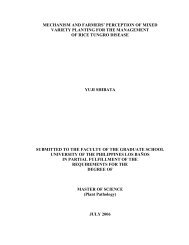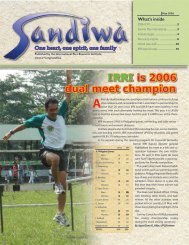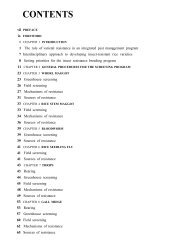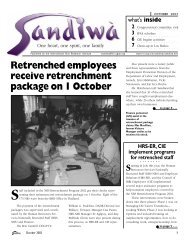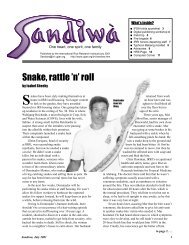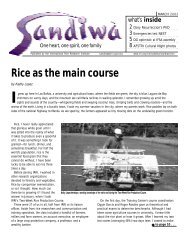Untitled - International Rice Research Institute
Untitled - International Rice Research Institute
Untitled - International Rice Research Institute
Create successful ePaper yourself
Turn your PDF publications into a flip-book with our unique Google optimized e-Paper software.
Fig. 28. Occurrence of bakanae (Ou 1985, Agarwal and Mathur 1988, EPPO 1997).<br />
c. Location on seed<br />
F. moniliforme is most likely observed on the entire<br />
rice seed (about 57%) (Fig. 31).<br />
Microscopic character<br />
a. Mycelia—hyaline, septated (Fig. 30d).<br />
b. Microconidiophore—single, lateral, subulate<br />
phialides formed from aerial hyphae, tapering<br />
toward the apex (Fig. 30e).<br />
c. Macroconidiophore—consisting of a basal cell<br />
bearing 2–3 phialides that produce macroconidia.<br />
d. Microconidia—hyaline, fusiform, ovate or clavate;<br />
slightly flattened at both ends; one- or twocelled;<br />
more or less agglutinated in chains, and<br />
remain joined or cut off in false heads (Fig. 30f).<br />
Measurements: 2.53–16.33 µ × 2.30–5.75 µ<br />
(PDA); 5.06–14.26 µ × 1.61–4.83 µ (PSA); and<br />
4.60–10.35 µ × 1.61–4.83 µ (OA, oatmeal agar).<br />
e. Macroconidia—hyaline, inequilaterally fusoid;<br />
slightly sickle-shaped or almost straight; thinwalled;<br />
narrowed at both ends, occasionally bent<br />
into a hook at the apex and with a distinct foot cell<br />
at the base; 3–5 septate, usually 3 septate, rarely<br />
6–7 septate; formed in salmon orange<br />
sporodochia or pionnotes (Fig. 30g). Measurements:<br />
18.86–40.71 µ × 2.76–4.60 µ (PDA);<br />
16.10–35.42 µ × 2.07–4.60 µ (PSA); and 21.39–<br />
39.56 µ × 2.53–4.60 µ (OA).<br />
Colony characters on culture media (Fig. 32)<br />
Colonies on PDA at ART (28–30 °C) grow moderately<br />
fast and attain a 5.20-cm diam in 5 d. They are<br />
slightly zonated; floccose to slightly felted, and become<br />
powdery with age; white tinged with pink at the<br />
center. The colony appearance on the reverse side of<br />
the agar plate is slightly zonated and white with a purplish<br />
center. At 21 °C under alternating 12-h NUV<br />
light and 12-h darkness, colonies grow slowly and attain<br />
a 3.72-cm diam in 5 d. They are slightly zonated,<br />
cottony to slightly felted with submerged advancing<br />
margins and pink. The colony on the reverse of the<br />
agar plate appears slightly zonated and dark pink and<br />
light toward the margin. At 28 °C under alternating 12-<br />
h fluorescent light and 12-h darkness, colonies grow<br />
moderately fast and attain a 5.10-cm diam in 5 d.<br />
They are zonated and appear cottony to slightly felted<br />
with sinuate margins, purplish at the center and light<br />
outward. Saltation of colonies is occasionally observed<br />
in some plates. The colony on the reverse side<br />
of the agar plate is zonated and purple and light purple<br />
outward.<br />
32



